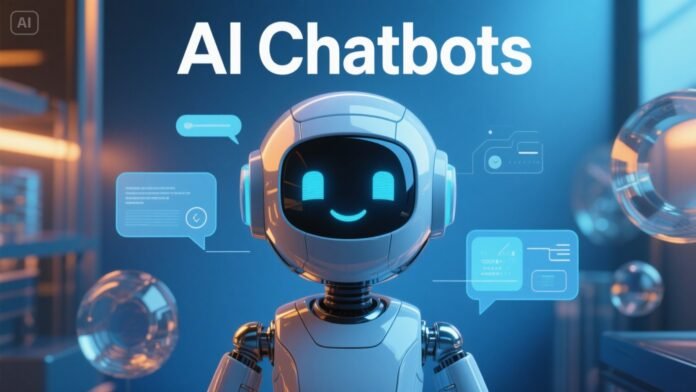Last Updated on November 7, 2025 by Tayyaba Shafqat
Education is one of the sectors that has been most transformed by the digital revolution. International education can be enriching, yet communication issues often arise. Imagine being a Chinese student trying to understand what his professor is telling them or a Brazilian working in a group with someone from across the globe – these scenarios often prove challenging when trying to work together effectively. And imagine that everyone lives in different time zones. Students and professors in international education face many communication barriers.
AI chatbots are effective in this situation, thanks to their advanced algorithms. Not only do they provide a bridge for communication, but they also help make students more interactive by offering personalized support. This makes the learning environment inclusive and effective. This paper will discuss the various communication barriers that exist in international education and present the capabilities of AI chatbots to overcome these barriers.
Table of Contents
Communication Barriers to International Education
Language Differences
Language is one of the biggest communication barriers in global education. It hinders effective communication for both teachers and students. A student from Japan studying in the United States might struggle with English. This could compromise the learning experience and academic performance. Teachers may also have trouble conveying complex concepts in a multidisciplinary class.
Language barriers don’t just involve words and pronunciations – they also encompass cultural references, local idioms and academic terminology that non-native speakers find unfamiliar – all of which can hinder student participation in class discussions and understanding course material.
Cultural Differences
Communication issues are also impacted by cultural differences. Each culture has unique values, norms, and communication structures which may lead to misunderstood expectations; students from collectivist cultures may struggle when joining groups where assertiveness–typical of more individualistic cultures–is expected.
Culture can have an influence on nonverbal forms of communication such as facial expressions, gestures and body language. While non-verbal communication is crucial for effective interactions across cultures, misinterpreting it could result in miscommunication between nations.
Time Zone Problems
Time zone differences present a unique challenge to global learning programs that span multiple time zones. Meetings, group work sessions and live chats may be challenging to schedule across time zones – this reduces communication speed and collaboration potential while making students feel isolated when forced to work at odd hours in order to accommodate others.
Accessibility of Technology
Though technology connects people, its limited availability can sometimes create barriers. Students without reliable internet access or appropriate devices may struggle to participate in online learning – resulting in a digital divide which hinders communication as well as effective learning and interactivity.
AI Chatbots Are Bridging Communications Gaps
Translating and Interpreting Languages
AI chatbots equipped with advanced translation and interpretation algorithms help reduce language barriers by translating both text and speech real time, mediating communication among students, educators, and peers despite language differences. A chatbot could instantly translate a student question into the professor’s language for immediate resolution.
Chatbots can also decode academic jargon and technospeak, enabling smoother and more accurate delivery of complex concepts. This not only enhances understanding, but it encourages interactive exchanges by decreasing anxiety related to language usage.
Cultural Sensitivity and Adaptability
AI-enabled bots can be programmed to understand culturally distinct communication norms. Chatbots can adapt their speaking style based on users’ cultural expectations for productive interactions that respect all parties involved.
AI chatbots also give teachers and students insight into cultural differences, helping them better relate and understand each other. A chatbot might for instance explain cultural references or behaviors while creating inclusiveness and spreading awareness among its users.
Time Zone Coordination
AI chatbots can facilitate improved cross-time zone collaboration by scheduling meetings and sending reminders – automating these tasks reduces miscommunication risk while strengthening collaborative relationships.
Chatbots provide students with asynchronous support, enabling them to gain access to information and get assistance at any time – providing better learning experiences across time zones.
Improvements to Accessibility
AI chatbots expand access to education for those with limited technological resources. Utilizable across platforms including social media and mobile apps, these AI bots make education available even to those without access to high-end devices.
Chatbots offer tailored learning resources tailored specifically for each student. For instance, they can deliver content using audio or text-to-speech functions that suit learning styles and accessibility needs.
Artificial Intelligence Chatbots Are Revolutionizing Global Education
Personalized Learning Support
AI chatbots excel at offering customized learning support. By processing individual student data and offering custom feedback, resources, and study suggestions; AI chatbots can even assist in understanding a concept with explanations, practice problems, or additional reading materials provided by their AI counterpart.
Students benefit from tailored support to help overcome obstacles, build self-confidence and boost academic performance.
Increased Interaction and Engagement
AI chatbots enhance learning engagement. They offer instantaneous feedback, quickly respond to queries and drive participation in discussion topics – making learning dynamic and responsive than ever.
These environments also create a safe, nonjudgmental space where students can express themselves freely – an invaluable benefit for introverted or shy students who find speaking up difficult in traditional classroom settings.
Effective Administrative Support
Artificial intelligence chatbots can assist educators by streamlining administrative tasks like scheduling, sending reminders and disseminating information – freeing them up to focus on teaching and mentoring their students instead.
These institutions excel at welcoming new students, helping them navigate academic systems and providing essential information that enables an easier transition into new learning environments – thus enriching student experiences and increasing retention rates.
Case Studies and Practical Applications are important components of modern life.
University of California at Berkeley
UC Berkeley has implemented AI chatbots to provide real-time language translation, cultural sensitivity assistance, and academic help tailored specifically for international students studying abroad. These chatbots also help overcome any potential hurdles associated with studying abroad.
Chatbots have proven invaluable in increasing student engagement by giving learners instantaneous access to help and information – ultimately improving both academic and social outcomes.
University of Melbourne
The University of Melbourne employs AI chatbots to facilitate collaboration with international students. Chatbots help bridge language gaps, coordinate time zones and deliver tailored instruction; ultimately creating a more inclusive academic environment.
Chatbots have enabled universities to improve academic performance and foster greater student participation by helping overcome any language barriers that existed between themselves and their diverse student body.
Future Prospects and Developments
As AI advances, chatbots will play an increasingly prominent role in international education. Future chatbots may include more sophisticated natural language processing capabilities which enable them to recognize complex and nuanced communication and respond accordingly.
Virtual and augmented reality technologies could offer immersive, engaging learning experiences. Such advances would further increase AI chatbots’ capacity to connect global students.
Educational institutions could collaborate to establish shared chatbot standards and best practices that would benefit students nationwide with high-quality support services.
Conclusion
AI chatbots are revolutionizing international education by eliminating long-standing communication barriers between students and educators. By offering features such as real-time translation, cultural sensitivity monitoring, time zone coordination coordination and enhanced accessibility – chatbots are creating more inclusive learning environments and immersive teaching environments.
AI chatbots are revolutionizing education by providing personalized learning, increased engagement, and smooth administration – benefits which AI chatbots will only grow stronger over time as technology develops further. Chatbots will continue to play an ever-increasing role in helping international students flourish within an interlinked academic landscape.
Educational institutions can leverage AI chatbot technology to enhance communication, establish inclusive learning communities, and enable all students to thrive.
Apart from that, if you are interested to know about “5 Reasons to Buy Wireless Headsets” then visit our “Technology” category.



























